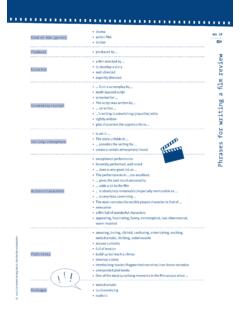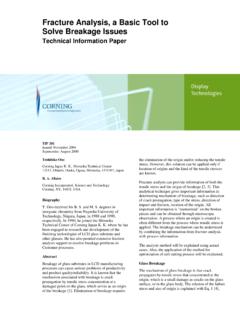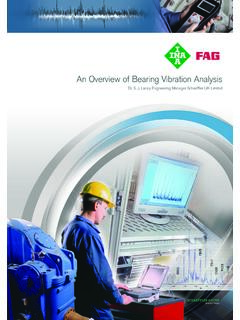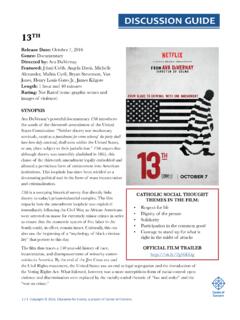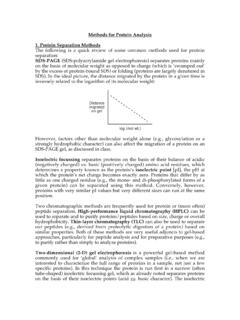Transcription of A Short List of Film Terms - Carnegie Mellon University
1 A Short List of film Terms Part of being a good film student is knowing the language of film . Here is a very brief introduction to some of the most common Terms you will run across in my lectures and at ETC. It is by no means comprehensive; nonetheless, it should give you some basic Terms to use when speaking and writing about your projects. For some of you, this list will be a review, but in everyone s case, be sure to clarify any Terms that you find confusing. A few of these Terms come from literary analysis and from the theater, but most are specific to film . narrative - An adjective describing a film as being primarily a work of fiction, or a noun that loosely means a fictional story. documentary - Also an adjective or noun category used to describe a work of nonfiction.
2 Plot - refers to all aspects of the narrative that we see on screen. For example, in the film Jaws, Chief Brody s talking to the town council on screen would be part of the plot. story - refers to all aspects of the narrative that we do not see on screen; these aspects may include events before, during, or even after the plot of the film . In Jaws, for instance, Chief Brody had been a police officer in the city prior to the film s beginning; this information is part of the story but not part of the plot. diegesis - refers to the narrative that we see on screen. This term is much more specific to film , however, and refers to the world that the characters inhabit as much as the plot of the film . The adjective diegetic, for instance, refers to something the characters in the film could perceive, whereas nondiegetic refers to something they could not (see diegetic and nondiegetic sound below).
3 Point of view - Most people assume film always has a third-person perspective, but even when it does not use a POV shot (see below), film often has a more subjective perspective through the use of camera placement, voiceover, and other cinema techniques. mise-en-sc ne - refers to everything in the frame of the film , which would include lighting, set, props, and the staging and movement of actors. The term derives from the theater, where it is used in a similar way. In the 1950s, a group of French critics at the journal Cahiers du Cin ma used this term in a different way. For them, mise-en-sc ne meant a special aspect of cinema associated with certain directors. Eventually, you will want to understand both meanings of the term, since this secondary meaning is closely connected to the idea of auteurism in Initially, however, use mise-en-sc ne in the first sense.
4 Setting - like the literary term, this word refers to the time and place of the film . The setting for The Usual Suspects, for instance, is New York and Los Angeles at a time contemporary with the film s year of release (in this case, 1995). set - This term refers to the actual construction in which the actors are filmed. In The Usual Suspects, for instance, a set might be the interrogation room in the film . Sets are usually built for a film , as opposed to shooting on location, where a scene is shot in the actual place in which it occurs in the film . If a film crew shot on location in Venice, Italy, for instance, they might actually be shooting the scene in gondolas on the canals. Set is also used generally, however, as a designation for the place where a film is being shot.
5 (So even in location shooting, the director would be on the set of his or her film every time he or she went to the place where the crew was shooting for that day.) prop - another term borrowed from theater. A prop is generally any object on a set, though clearly the objects that characters will touch become more important. A trumpet, for instance, might be part of the backdrop in a music store scene, but if a character is going to play the trumpet, the prop takes on more importance. costumes - what the characters are wearing. Bear in mind that even if a character is wearing contemporary clothing (in some cases, the actors own clothing), that clothing is still considered a costume. lighting - This term refers to the way in which lights are used for a given film .
6 Lighting, in conjunction with the camera, sets the visual look for a film . The key light is the main light used for a scene; back light refers to a secondary source, usually placed behind the actors; and fill refers to a light placed to the side of the actors. This system is called three-point lighting and was very common in classical Hollywood films. You may also run across the term low-key lighting, which means that the film was shot often using only the key light at a very low setting. This low level of lighting creates dark shadows on the faces of actors and is particularly moody when used with black-and-white film . It is most often associated with film noir but is not exclusive to that genre.
7 Shot (and close-up v. long shot) - generally, the smallest unit of unbroken film . The camera can move within a shot, but the second that the film makes a transition (see below) to another shot, the previous shot has ended. Alternatively, when used with certain adjectives, shot also refers to the distance from the camera to the subject, almost always the actor. In a long shot (or a wide shot), one can see the entire body of the actor; in a medium shot, one can see the actor from the waist up; in a close-up, one can see only the actor s face (there is no such term as the Short shot ). You might also see an extreme close-up in a film , where you can only see part of the actor s face (just the eyes, for example).
8 Also, another common term is the two-shot, which is generally a medium to medium-long shot of two actors; two-shots were very common in the classical Hollywood era and continue to be used today. pan - the movement of a stationary camera on a horizontal axis. A camera on a tripod that moves from left to right (following a parade, for instance), would be panning. tilt - the movement of a stationary camera on a vertical axis. A camera on a tripod that moves up and down (following a plane landing, for instance), would be performing a tilt. tracking shot - the movement of the shot when the camera is no longer stationary. The term refers to the tracks that cameras were once rolled on when creating one of these shots.
9 Although tracks are still often used with a tracking shot, the term might also refer more generally to a moving shot that appears stable, such as a steadicam shot, which uses a gyroscope to avoid the shaky effects associated with hand-held shots. You may also run across the term dolly shot, which refers to what the camera rests on (a platform with wheels) while the camera moves in certain kinds of shots. Dolly shot is sometimes used interchangeably with tracking shot, since dollies very often use tracks. handheld shot - refers to a shot where the camera is held by the camera operator. Hand-held shots are often associated with a certain look, which is shaky, and most people associate the hand-held shot with a kind of documentary realism.
10 Narrative films and television often use the hand-held for this reason, as they are able to create a sense of gritty realism. The television show Law and Order, for instance, often uses hand-held shots when the detectives are questioning suspects on the streets, giving the viewer the sense that the scene is more real. Bear in mind, however, that no one technique ever has the same meaning in every film (a handheld shot might be used to decrease the sense of realism). crane shot - A shot taken from a crane. You often see these shots at the beginning of a scene (using it as an establishing shot) or the end of a scene. The end of a movie, in fact, often uses a crane shot (though sometimes is even more extreme).
